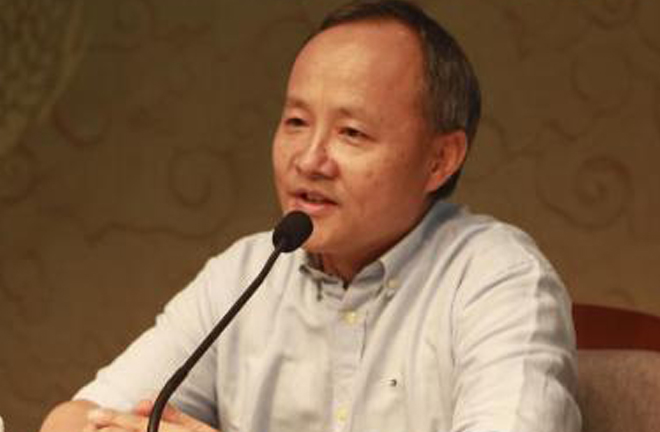YE SHUXIAN: Chinese mythology embodies origins, foundations of traditional culture
 Myths form the basis of literature and a particular culture. When they hear “Chinese mythology,” people usually think of stories such as Nüwa Mending the Heavens, Houyi Shooting the Suns and Chang’e Flight to the Moon. Many may think that, compared with the West, Chinese mythology is just a collection of the explanatory stories produced by ancient people’s unsystematic attempts to understand nature. However, as a form of cultural gene, the legacy of myth is an effective way by which the origins of Chinese tradition are accessed.
Myths form the basis of literature and a particular culture. When they hear “Chinese mythology,” people usually think of stories such as Nüwa Mending the Heavens, Houyi Shooting the Suns and Chang’e Flight to the Moon. Many may think that, compared with the West, Chinese mythology is just a collection of the explanatory stories produced by ancient people’s unsystematic attempts to understand nature. However, as a form of cultural gene, the legacy of myth is an effective way by which the origins of Chinese tradition are accessed.
There is no such concept as myth in the history of Chinese civilization and the term did not even appear in the vast lexicon of ancient Chinese characters. During the eastward spread of Western culture—roughly lasting from the late Ming Dynasty (1368-1644) until the early modern era—Japanese scholars translated the English word “myth” into Chinese characters. Later in 1902, some Chinese students studying in Japan introduced the term into Chinese, which opened the door for domestic Chinese research on mythology.
Afterward, research in China underwent several transitions. In the field of literature, writers such as Zhou Zuoren, Mao Dun and Xie Liuyi did much work to compile and reimagine the mythical stories scattered throughout the ancient Chinese classics, laying a foundation for the study of Chinese mythology. In the field of historiography, scholars of the Doubting Antiquity School, such as Gu Jiegang and Yang Kuan, whose historic ideas were characterized as anti-traditional, questioned the historicity of myth in an effort to separate myths from real history.
Scholars represented by Xu Xusheng and Ding Shan, using archaeological findings and paleographical methodology, tried to verify the elements of historical truth embodied in the story of Chinese legendary figures Yao, Shun and Yu, the prehistoric leader-chiefs of allied tribes.
In the 21st century, the study of myths, once again has become one of the focal points of academic research. Chinese scholars started to reexamine this branch of the discipline that is called the source of human spirit by means of new theories and methodology.
I propose to reflect on mythology from the perspectives of “small tradition” and “big tradition.” The former refers to the writing tradition of Chinese characters, including oracle bone script and bronze script as the precursors, and a set of narratives by means of inscriptions that emerged later. The latter comprises the cultural tradition of unrecorded protolanguage in the pre-linguistic era and the oral cultural tradition that paralleled the writing tradition that subsequently emerged.
In conducting the cultural study within the framework of the “big tradition,” the primitive pre-linguistic system of symbolic communication existing prior to the originations of words, as what most approximately bears the textual significance is particularly worthy attention. Take jadeware for an example. It has been considered the most salient symbol of Chinese mythical culture according to the archaeological findings hitherto. What were the factors that sustained such an enduring and widely spread jade culture, which originated as early as more than 8,000 years ago? The answer is that the Chinese ancestors believed that jade represents heaven, god and the ideal of immortality. Undoubtedly, the myth of jade is a unique cultural gene of Chinese civilization.
In addition to the mythical imagination among the ancestors, a mythical China can also be found in Confucian temples seen today in many counties and towns, and in such rituals of Chinese folk religion as the Stove God, the domestic god that protects the hearth and family, and the Door God, the divine guardian of doors and gates, as well as the memorial tablets for the forefathers in many households. Harmony between man and the universe—such a concept in Chinese mythical culture has never been abandoned. This is what makes Chinese mythology distinctive from the West and what intrinsically characterizes Chinese culture.
The value of myths is their ability to interpret the past and the present, more and to some extent, they are auspicious of the future as well. In this sense, to examine Chinese mythology is not merely to reveal the mythical manifestations in a particular piece of work, or to combine the study of myths that is conventionally limited in folk literature with excavated documents and archaeological images. More importantly, the aim is to seek the internal values and world views that are uniquely embodied, which is emblematic of the prototype of traditional Chinese culture.
This article is edited and translated from the People’s Daily. Ye Shuxian is a chair professor from the Shanghai Jiao Tong University, the director of the Association of Chinese Mythology, and the deputy director of the Chinese Comparative Literature Association.
(edited by BAI LE)
